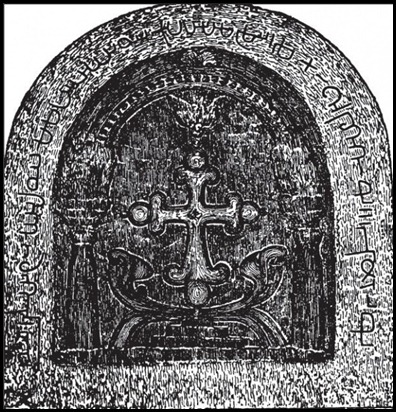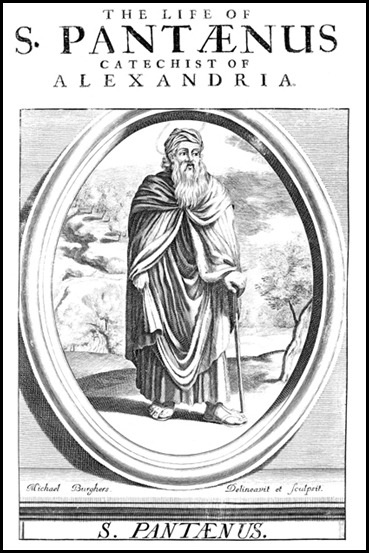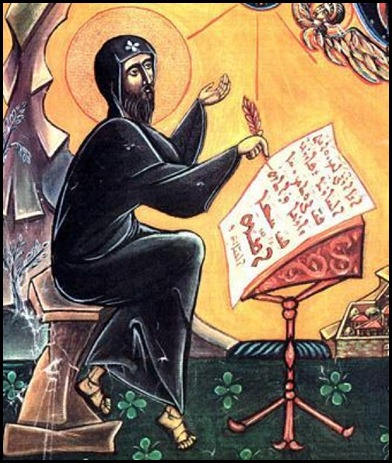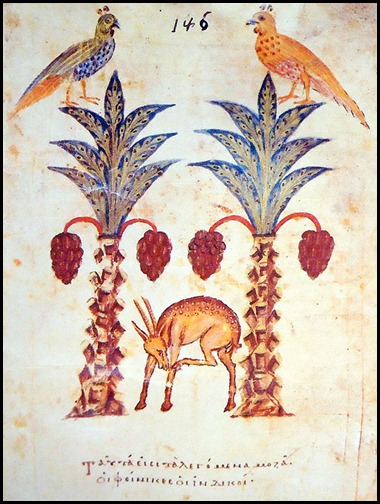SCHOLARSHIP OF SAINT BASIL THE GREAT 2012
The ancient Saint Thomas Christians of Kerala are known as ‘Nasranis’ or ‘Nasrai Mappilla’. ‘Nasrani’ is a term meaning ‘Christian’ and appears to be derived from Nazareth. Mappilla is an honorific applied to members of non-Indian faiths, including Muslims. Some Christians of the former Kingdom of Travancore still continue to use this honorific title. The Saint Thomas Christians are often called Syrian Christians because of their ancient connection to the Church of the East and thus the use Syriac as their liturgical language. Syriac is a derivative of Aramaic, the language of Christ, and is, for my purposes, divided here between East Syriac and West Syriac (example pronunciation: East - mAr, West – mOr). This will become more important later in my travels when I go and live in a West Syriac community. Yet another term for them is Malabar or Malankara Mar Thoma Nasranis, as Kerala was also known as Malabar or Malankara. Their indigenous language is Malayalam.
The earliest known source connecting the Apostle to India is the apocryphal book The Acts of Thomas, written in Edessa in the 2nd century, a copy of which still survives in Saint Catherine’s monastery on Mount Sinai. The text describes Thomas's adventures evangelising India, a tradition later expanded upon in early Indian sources such as the ‘Thomma Parvam’ ("Song of Thomas"). The Acts of Thomas hints that Saint Thomas came to India with a Jewish trader. Scottish historian William Dalrymple travelled across the Arabian Sea to Kerala in a boat similar to those mentioned in Roman texts to show how the traders had travelled from the Middle East to Kodungulloor. He followed the same course as mentioned in The Acts of Thomas. At the time the area from Syria to Patria was under Roman rule and so traveling through this region was relatively easy. The Jew’s name is given as Haban and it is believed that they both reached Kodungalloor (Cranganore) in 52AD. Once in India Saint Thomas first stayed with the Jewish community where he is believed to have converted many of them to Christianity.
These communities would have been multi-ethnic and included native Indians of Aryan, Dravidian and Naga ethnicity who could have been baptized by Saint Thomas as well as members of the different trading diasporas of Jews as well as Christian settlers who came later. They may also have included groups such as the Knanaya people (an early Jewish group of converts to Christianity who still retain their Jewish ethnicity and customs which I will write about at a later point).
In 190AD, Pantaenus from Alexandria visited these Christians and found that they were using the Gospel of Matthew in Hebrew. Eusebius of Caesarea reports that Pantaenus, his teacher, had been told that this Gospel book had been brought to them by the Apostle Bartholomew. St Jerome reported that Demetrius of Alexandria had sent Pantaenus to India where he
“found that Bartholomew, one of the twelve Apostles, had preached the Advent of the Lord Jesus according to the Gospel of Mathew, and on his return to Alexandria he brought this with him written in Hebrew characters.”
The Tamil epic of Manimekkalai written between the 2nd and 3rd centuries AD mentions the Saint Thomas Christian people by the name Essanis referring to one of the early Jewish-Christian sects within the Nasranis called Essenes. A number of 3rd- and 4th-century Roman writers mention Thomas's trip to India including St Ambrose of Milan -
“When the Lord Jesus said to the Apostles, go and teach all nations, even the kingdoms that had been shut off by the barbaric mountains lay open to them as India to Thomas, as Persia to Mathew.”,
St Gregory of Nazianzus -
“What! were not the Apostles foreigners? Granting that Judea was the country of Peter, what had Saul to do with the Gentiles, Luke with Achaia, Andrew with Epirus, Thomas with India, Mark with Italy?,
St Jerome, and St Ephraim the Syrian -
“It was to a land of dark people he was sent, to clothe them by Baptism in white robes. His grateful dawn dispelled India's painful darkness. It was his mission to espouse India to the One-Begotten. The merchant is blessed for having so great a treasure. Edessa thus became the blessed city by possessing the greatest pearl India could yield. Thomas works miracles in India, and at Edessa Thomas is destined to baptize peoples perverse and steeped in darkness, and that in the land of India."
— Hymns of St. Ephraem, edited by Lamy (Ephr. Hymni et Sermones, IV).
These all demonstrate that the tradition of the evangelisation of India by Saint Thomas the Apostle was a well known.
According to the 7th century Chronicle of Seert Bishop David of Basra under Patriarch Mar Papa of Seleucia-Ctesiphon evangelised India in the tear 295. However we only have this one source for this information. So whatever its earlier origins, an organised Christian presence in India dates at least to the arrival of East Syrian settlers and missionaries from Edessa or Iraq under the leadership of Thomas of Cana, members of the Church of the East, in 345AD. King Charaman Perumal gave permission for these Christians to settle in Kerala. Around AD 522, an Egyptian Monk, Cosmas Indicopleustes visited the Malabar Coast and mentions the Christians of Malabar in his book Christian Topography – Book Three.
“The Gospel has been preached throughout the world. This I state to be definite fact from what I have seen and heard in the many places i have visited…in the country called Male (Malabar) where pepper grows, there is also a church, and at another place called Kalliana (Kalyan, Mumbai) there is moreover a bishop, who is appointed from Persia.”
Saint Thomas Christians trace the further growth of their community to the arrival of more Nestorian traders from the Middle East in 825AD. They had their own bishops visiting them from Persia and these were welcomed by the Saint Thomas Christians as these bishops made no effort to subjugate them. The subgroup of the Saint Thomas Christians known as the Southists trace their lineage to Thomas of Cana’s Assyrian Christians, while the group known as the Northists claim descent from Saint Thomas the Apostle's indigenous converts.
As the community grew and immigration by East Syrians increased, the connection with the Church of the East, centred in the Persian capital of Seleucia-Ctesiphon, strengthened. From the early 4th century the Patriarch of the Church of the East provided India with clergy, holy texts, and an ecclesiastical infrastructure. It is documented that Mar John, the Bishop of Great India, attended the council of Nicaea in 325 and signed himself as ‘John the Persian presiding over the Churches in the whole of Persia and Great India.’ In 350AD Mar Aprem the Syrian wrote hymns about St Thomas’s evangelisation of India:
“Blessed art Thou, like unto the solar ray from the great orb; thy grateful dawn India's painful darkness doth dispel. Thou the great lamp, one among the Twelve, with oil from the cross-replenished, India’s dark night flooded with light.
Blessed art Thou whom the great King has sent, that India is to his One-Begotten thou shouldest espouse; above snow and linen white, thou the dark bride didst make fair
Blessed art Thou, O thrice-blessed city; Thou hast acquired this pearl, none greater doth India yield
Blessed art Thou, worthy to possess the precious gem! Praise to Thee O gracious Son, Who does thee adore does enrich.”
Around 650 Patriarch Ishoyahb III solidified the Church of the East's jurisdiction over the Saint Thomas Christian community. In the 8th century Patriarch Timothy I organised the community as the Ecclesiastical Province of India, one of the church’s ‘illustrious Provinces of the Exterior’. After this point the Province of India was headed by a metropolitan bishop, provided from Persia, the "Metropolitan-Bishop of the Seat of Saint Thomas and the Whole Christian Church of India". His Metropolitical see was probably in Cranganore, or (perhaps nominally) in Mylapore, the traditional place of Saint Thomas’s martyrdom and where his shrine was located. Under him were a varying number of Assyrian bishops, as well as a native hereditary Archdeacon, who not only had authority over the clergy and who wielded a great amount of secular power but also acted as the indigenous cultural ‘head’ of the church as far as the caste system went.
The Rulers of Kerala gave the Nasranis various rights and privileges written on copper plates. These are known as Cheppeds, Royal Grants, or Sasanam. There are a number of such documents: Thazhekad Sasanam; The Quilon Plates (Tharisappalli Cheppeds); Mampally Sasanam; and Iraviikothan Chepped (Copper Plate). Some of these plates date to 774 AD. The language used is Tamil in Tamil letters with some Grantha script intermingled . The Quilon Copper Plates which were given to Mar Sapor and Mar Prodh, brothers (referred to as Kaddisangal or Saints by the Church of the East) who immigrated to Quilon from Persia in 823 AD, also include some Pahlavi, Kufic and Hebrew signatures. The plates show that the ruler of Venad (Travancore) granted Syrian Christians seventy two rights and privileges usually granted only to high dignitaries, including exemption from import duties, sales tax and the slave tax. Yet another copper plate from 1225 further enhanced the rights and privileges of the Nasranis. These copper plates are considered some of the most important historical legal documents in Kerala.
There are many accounts of foreign visitors from the West and Western missionary activity in India before the arrival of Portuguese. In 883AD, Alfred the Great, King of Wessex reportedly sent gifts to Mar Thoma Christians of India through Sighelm, Bishop of Sherborne. Around 1292AD, Marco Polo on his return journey from China visited Kerala, mentions that, "The people are idolaters, though there are some Christians and Jews among them". John of Monte Corvino was a Franciscan sent to China and became prelate of Peking in 1307. From Persia he travelled by sea to south India, or ‘The Country of St. Thomas’, in 1291. He stayed to preach and baptise for thirteen months. Monte Corvino wrote home in December 1291 (or 1292) leaving us one of the earliest noteworthy accounts of the Malabar coast written by a Western European.
Odoric of Pordenone arrived in India in 1321. He visited Malabar landing at Pandarani, Cranganore, and Quilon before sailing to Ceylon and then onto the shrine of Saint Thomas at Mailapur. He exitededly reported that he had found the place where Saint Thomas was buried. Father Jordanus, a Dominican, followed in 1321–22. He reported to Rome, apparently from somewhere on the west coast of India, that he had given a Christian burial to four martyred monks. Between 1324 and 1328 he seems to have visited Quilon and selected it as his ecclesiastical centre. He was appointed a bishop in 1328 and nominated by Pope John XXII in his bull Venerabili Fratri Jordano to the see of Columbum or Quilon on 21 August 1329. This was the first Roman Catholic diocese in the whole of the Indies, with jurisdiction over modern India, Pakistan, Afghanistan, Bangladesh, Burma, and Sri Lanka. Either before going out to Malabar as bishop, or during a later visit to the west, Jordanus probably wrote his Mirabilia. This work is the best account of the regions of India and its: products; climate; manners; customs; and fauna and flora given by any European in the Middle Ages – surpassing even Marco Polo's.
In 1347, Giovanni de' Marignolli visited the shrine of St Thomas in South India, and then proceeded to what he calls the kingdom of Saba, which he identifies with the Sheba of Scripture, but which actually seems to have been Java. Another prominent Indian traveler was Joseph, a priest from Cranganore. He journeyed to Babylon in 1490 and then sailed to Europe and visited Portugal, Rome, and Venice before returning to India. He helped to write a book about his travels titled The Travels of Joseph the Indian which was widely disseminated across Europe.
ROUGH TIMELINE
1st CENTURY
• 40 Apostle Thomas in the service of King Gondophares in
Takshasila in Pakistan.
• 52 Apostle Thomas landed at Muziris near Paravur, an ancient port city of Malabar (Present-day Kerala).
• 52–72 The Apostle founded the 7 churches.
• 72 Apostle Thomas martyred at St. Thomas Mount in
Chennai and is buried on the site of San Thome Cathedral.
2nd CENTURY
• 190 Pantaenus, the founder of the famous Catechetical School of
Alexandria, visited India and the Nasrani. He found that the
local people were using the Gospel according to Matthew in
Hebrew language. He took this Hebrew text back to his library at
the School in Alexandria.
4th CENTURY
• 325 Archbishop John of Persia and Great India at the first
Ecumenical Council of Nicaea.
• 345 First migration from Persia – Thomas of Cana landed at
Cranganore with 72 families.
• 340–360 Thazhekad Sasanam written in Pali the language
the canonical language of Buddhists, the Nasrani granted special rights and privileges.
• 345 Kuravilangad Church (Now Martha Mariam Catholic church) built by the first settlers who came from Kodungalloor.
• Arrival of Mar Joseph of Edessa.
5th CENTURY
• 510 Udayamperoor (Diamper) church built by St.Thomas
Christians.
• 522 Cosmas Indicopleustes visited South India.
8th CENTURY
• 774 Emperor Veera Raghava gives copperplate to Iravikorthan.
9th CENTURY
• 824 Beginning of Kollavarsham (Malayalam Era). First Tharissapalli sasanam (Copper plate) by Stanu Ravi Gupta Perumaal to Nazranies.
• 824 Mar Sabor and Mar Afroth from Persia at Quilon.
• 849 Deed given by King Ayann Adikal Thiruvadikal of Venad, to
Easow-data-veeran (Tharisapalli plates) that grants 72 royal
privileges of the Nazranies in which the Nasranis signed in three
languages: Hebrew Pahlavi and Kufic.
11th CENTURY
• 1123 Arakuzha church founded, now known as St
Mary's Forane Church.
13th CENTURY
• 1225 North Pudukkad church founded.
• 1293 Marco Polo visited the tomb of St.
Thomas (at Mylapore).
14th CENTURY
• 1305 St. Hormis church, Angamaly founded.
• 1325 Enammavu church founded.
• 1328 St. George church, Edappally founded.
15th CENTURY
• 1490 Two Nestorian bishops Mars John and Thomas in Kerala.
• 1494 June 7 - Treaty of Tordesillas. Division of the world and
mission lands between Spain and Portugal.
• 1498 May 20 - Vasco de Gama lands at Kappad near Kozhikode.
• 1499 Cabral’s fleet carried a vicar, eight secular priests, and eight Franciscans to Kozhikode.
• 1499. In Calicut, the friars reputedly converted a Brahman and some leading Nayars.







